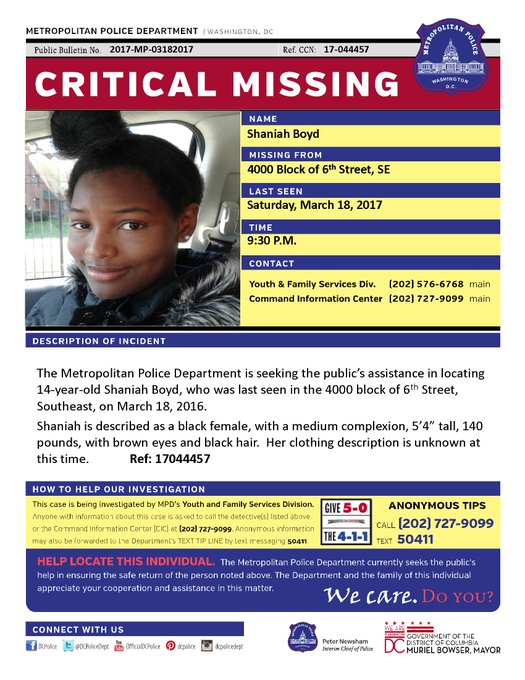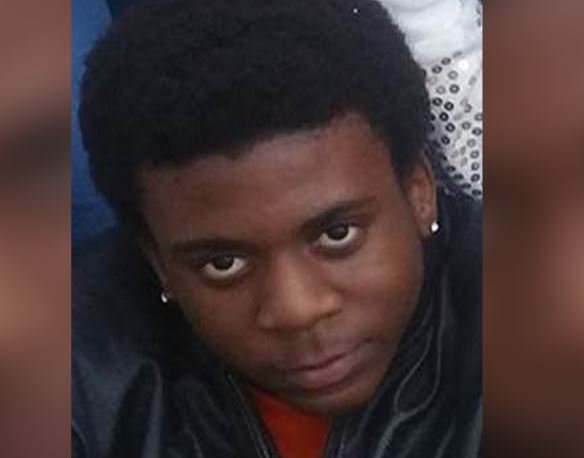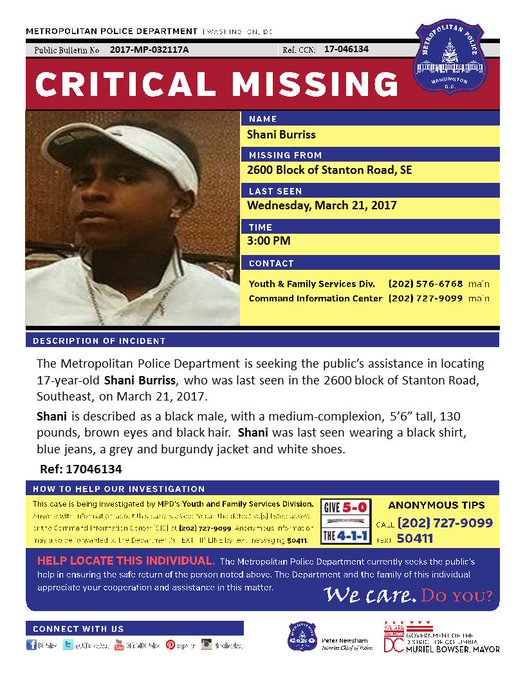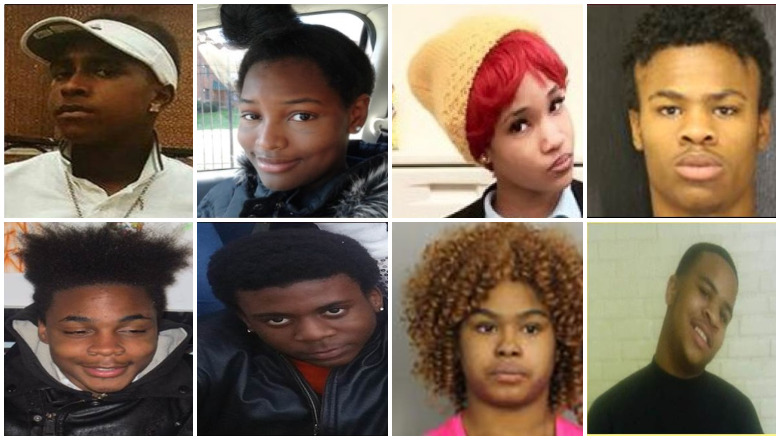
Some of the teens reported missing recently in Washington D.C., as of March 23. (D.C. police)
More than a dozen Washington D.C. teens are missing from the nation’s capital, police say.
That was the number as of March 23; it changes constantly as more youths are found and go missing.
The string of missing teenager cases – especially as many of them have been African-American and Latina teens – has generated community concern, with some on social media accusing the media and police of downplaying the story. Police say that missing people numbers have not increased from previous years, and most of the missing youths end up coming home, having left voluntarily.
In fact, some names being shared on social media and in news reports and maps are of teens already found. Many of the photos shared on social media are of missing DC girls and the hashtag #missingDCgirls is trending, but many of the missing teens are males.
Indeed, the increased exposure on the issue appears to have originated with the police itself, and a new commander determined to draw attention to each missing person.
Shaniah Boyd, 14, and Anjel Burl, 16, are African-American teenagers who vanished on March 17-22. They are the most recent cases. Chareah Payne, 17, was also reported missing, but police said on Twitter she was located in good health, as but one example of a teen lost and then found.
Here’s what you need to know:
1. Police Say a Dozen Teens Are Missing in D.C. but Said the Number Is Steady From Previous Years
As of March 23, “over a dozen District teenagers, ranging in age from 14 to 18, are missing,” reported NBC Washington.
At least 10 African-American girls went missing in one recent week, according to WPGC.
Acting Police Chief Peter Newsham told the television station that “the year-over-year number of missing persons, including juveniles, has held steady, and that there is no known link in D.C. now between missing people and human trafficking.”
In a press conference, which police posted on Periscope, the chief said that people go missing for many reasons but vowed to do everything to locate the teens. Some are runaways and dealing with family problems, he noted. The missing teens are not believed to have all met with foul play or to be connected.
The mayor, Muriel Bowser, concurred. At the press conference March 16, she said, “The number of missing person reports has remained constant…what has changed is getting that information out quickly. There is no evidence to suggest there has been an increase in missing persons.”
Chanel Dickerson, commander of the division in charge of investigating the missing teens, said in the press conference: “Let me first reassure you. We have no indication to believe that young girls in the district are being preyed upon by human traffickers in large numbers.”
Dickerson said that, out of 708 missing persons reports in 2017, only 34 remain open. “We have no reason to believe the 34 missing cases are related,” she said, and all don’t involve juveniles.
2. Residents & Community Leaders Pressed Police & the Mayor for Answers, Calling the Missing Teens an ‘Epidemic’
Attendees at a packed community meeting pushed the mayor and police officials for answers on March 22.
“You can tell by the packed room that this is something a lot of people care about,” Ward 8 D.C. Councilmember Trayon White said, according to News One. “Over the past couple of years, I’ve been seeing a lot of the postings, hearing from a lot of family members, going to a lot of prayer vigils. There’s been an epidemic of missing persons in the Washington D.C. area.”
One of the most recent teens to go missing, Boyd, was last seen in the 4000 block of 6th Street, Southeast, on March 18, 2017, police said in a missing person’s alert.
She was described as a black female with a medium complex, 5 foot 4 inches tall, 140 pounds, with brown eyes and black hair. Her clothing description was unknown.
3. The Other Names Range From Anjel Burl to Vaneisha Weaver
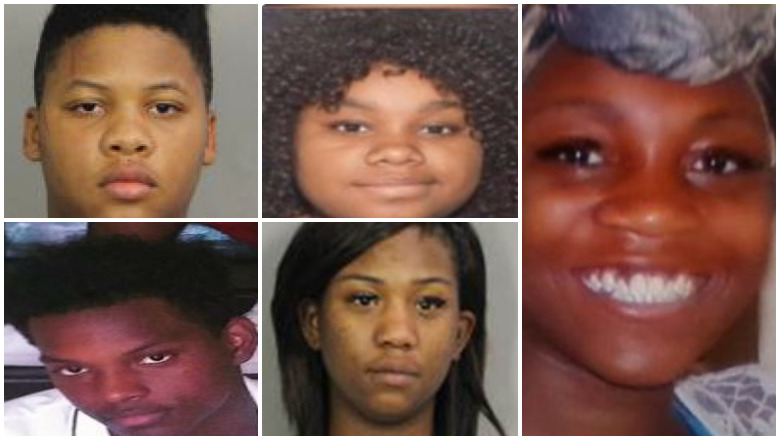
More of the missing teens reported as of March 23. (DC police)
Burl was last seen in the 200 block of 43rd Road, Northeast, on March 22, 2017, police said in her missing person alert.
She was reporting missing on March 23. She was described as a black female, light-complexioned, 5 foot tall, 90 pounds with brown eyes and red hair. She was last seen wearing a light blue polo style shirt, tan stretch pants, a yellow and pink north face jacket, a yellow knit hat and black and white Jordan sneakers.
As of March 23, according to the police website, these were the other teenagers missing in D.C. (some were later located, but police had not updated the website, so Heavy is not including those cases):
Shani Burriss, 17, who was last seen in the 2600 block of Stanton Road, Southeast, on March 21, 2017. Shani is described as a black male, with a medium-complexion, 5’6” tall, 130 pounds, brown eyes and black hair. Shani was last seen wearing a black shirt, blue jeans, a grey and burgundy jacket and white shoes.
Rayquon Blakeney, 19, who was last seen on Friday, March 17, 2017, in the 1400 of Howard Road, Southeast. He was reported missing on March 20, 2017. Blakeney is described as a black male, with a medium brown complexion, 5’ in height, 125 pounds, with black hair and brown eyes. He was last seen wearing a gray hoodie, a black jacket, and blue jeans.
Jaylen Lee, 14, who was last seen Saturday, March 18, 2017, in the 1000 Block of Maryland Avenue, Northeast. Lee is described as a black male, medium brown complexioned, 5’7” in height, 140 pounds, with brown eyes, and black hair. He was last seen wearing a black jacket, blue jeans, a black hooded sweatshirt and black shoes.
Makel Barnes, 15, who was last seen in the Unit Block of Galveston Street, Southwest, on Wednesday, March 15, 2017.Barnes is described as a black male, dark-complexioned, 5’10” in height, 200 pounds, with black hair and brown eyes. He was last seen wearing a white shirt, a burgundy jacket with a grey hood, dark blue jeans and black sneakers.
Dashann Wallace, 15, who was last seen in the 200 block of I Street, SE, on Monday, March 8, 2017. Dashann is described as a black female, 5’1” tall, 140 pounds, medium complexioned, with hair black in color and brown eyes. Her clothing description is unknown .
Zyaire Flemmings, 15, who was last seen between, Thursday, February 23, 2017, at 2 pm and Friday, February 24, 2017, at 1:32pm, in the 4200 block of 4th Street, SE. Flemmings is described as a black male, medium complexion, 5’9” in height, 160 pounds, brown eyes, and black hair. He was last seen wearing a blue/white jacket, blue jeans and grey New Balance sneakers.
Navaras Lorenzo Johnson, 14, who was last seen in the Unit Block of Galveston Street, SW, on Monday, February 27, 2017. The incident was report on March 1, 2017. Navaras is described as a black male, light complexion, 5’6” in height, 175 pounds, with brown eyes, and black hair. He was last seen wearing a white shirt, a black jacket, blue jeans, and black sneakers.
Vaneisha Weaver, 18, who was last seen in the 1400 Block of Columbia Road, NW, on Thursday, February 16, 2017. She was reported missing on February 21, 2017. Weaver is described as a black female, medium-complexioned, 5’7” tall, 180 pounds, with black hair and brown eyes. She was last seen wearing a red jacket and blue jean pants.
Demetria Carthens, 17, who was last seen on Tuesday February 7, 2017, in the 200 block of I Street, Southeast. Carthens, is described as a black female, medium complexioned, 5’5” in height, 130 pounds, with black hair and brown eyes. She was last seen wearing a thin blue coat, black jeans and black boots.
Faith Nelson, 16, who was last seen on Friday January 13, 2017, Faith left her residence at 7:00 am, in the 3500 block of Minnesota Avenue, SE. Faith Nelson was reported missing on Monday, January 30, 2017. Nelson, is described as a black female, medium complexion, 5’2” in height, 120 pounds, with black hair and brown eyes. Her clothing description is unknown.
Clayton Carter, 17, who was last seen in the 200 Block of I Street, Southeast, on Saturday, January 11, 2017. Carter is described as a black male, 6’1” tall, 173-175 pounds, with brown eyes, black hair, and a medium complexion. He was last seen wearing unknown clothing.
4. The Mayor Said the Number of Missing Person Alerts Raised Concern but Police Have Purposely Tried to Increase Attention
The police and mayor have attempted to use social media and new technology to raise attention on the issue. This seems to be working based on the flurry of recent social media activity around the missing D.C. teens. However, some are now blaming police for inaction, when the police attempt to gain exposure to the issue started the flurry of interest in the first place.
In 2016, Dickerson said, she made it a priority to increase exposure in the cases. Police did not previously publicize each missing person case to the degree they do now.
In the March 16 press conference, the Washington D.C. mayor said, “We are here to send a clear message that we will continue to use every resource available to us to protect our city’s most vulnerable residents.”
“We have a level of concern over the number of missing person alerts that MPD has recently sent. Many of those alerts relate to missing young people,” the mayor acknowledged.
5. Most Washington D.C. Missing People Are Found
The police chief said in the news conference that most missing people in D.C. end up being found. In 2017, so far, he said that 95% of missing people have been found.
In 2016, he said, 1,000 fewer missing people were reported in Washington D.C. than in 2012.
At the community meeting, people were extremely concerned:
Since 2012, parents or guardians reported almost 200 juveniles missing per month, Dickerson said. In 2017, that number dropped to 190 per month. From 2012-2016, over 99 percent of all missing person cases were closed. Sixteen out of 19,000 cases remain open.
“Most of the people reporting missing in D.C…have decided not to check in at home, at work or school for voluntary reasons,” she said.

